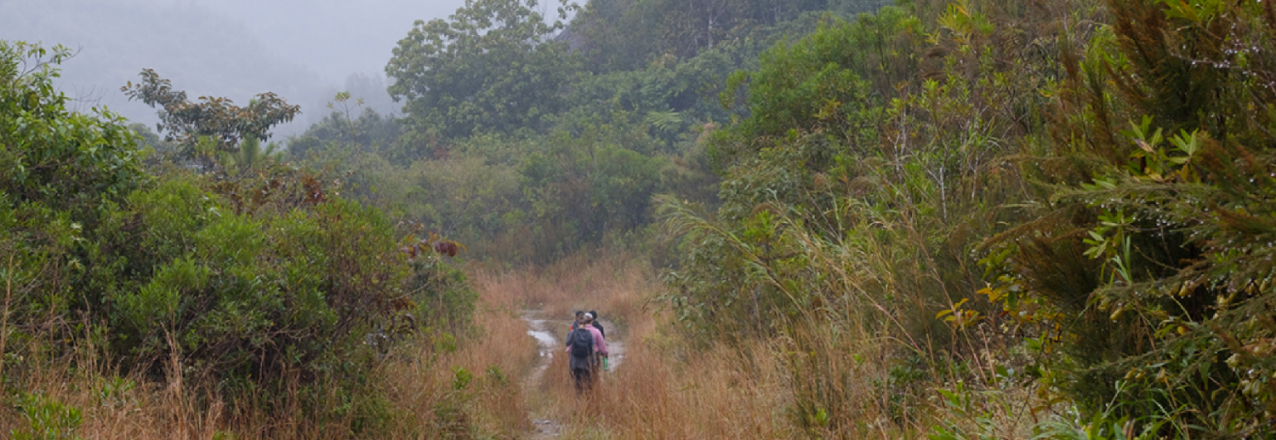EXECUTIVE SUMMARY
PURPOSE OF THIS BRIEF
Community forest management (CFM) is an approach to forest management and use that prioritizes the local population’s role. This brief provides United States Agency for International Development (USAID) staff who design and work on CFM activities with an accessible summary of Hajjar et al. (2020), a recent global synthesis of 697 cases in the CFM literature, including recommendations relevant to Agency programming. It highlights findings related to associations between CFM context factors and the achievement of positive CFM outcomes across multiple dimensions, while drawing attention to current knowledge on tradeoffs between CFM outcomes and the contexts in which such forests are often embedded. The brief outlines potential complementarities and divergences in Hajjar et al.’s findings with USAID CFM documentation including the Sourcebook for Community-Based Forestry Enterprise Programming, which synthesizes lessons learned from activities focused on community forestry-related private enterprises.1 In doing so, the brief points to opportunities for USAID to improve future activity designs and contribute to more effective CFM activity design and programming.
OVERVIEW OF CFM
Over the past decade, USAID has funded CFM activities around the globe to empower local communities, improve livelihoods, and protect the environment. Government- and donor-led programming in USAID partner countries to help communities address deforestation has changed over the past 40 years. While efforts previously focused on involving communities in state activities, programming now tends to support devolved management and use rights.
Research has highlighted several general drivers of CFM success, but there are still many questions about the specific impacts and drivers of observed change. In addition to forest outcomes, related governance and livelihoods outcomes including equity outcomes, for communities involved in CFM, are still open questions in the literature. While individual studies may address conservation or socioeconomic impacts, there has been limited analysis of the tradeoffs between different outcomes.
HIGHLIGHTS FROM HAJJAR ET AL.
Hajjar et al. includes the following key findings from the global literature on CFM:
Environmental and income benefits often appear to be achieved together. Most cases that reported on both income and environmental outcomes found positive change in both dimensions. It was less common for cases to document tradeoffs between these two sustainability dimensions (i.e., a decline in incomes but an increase in environmental outcomes, or vice versa). However, income distribution within communities can be problematic. About half of the cases examined reported that benefit sharing had become less equitable or mostly inequitable following CFM. Other studies provide many examples of wide disparities in who benefits from CFM within communities.
Declining forest resource rights and distributional asymmetries within communities are common. While information on forest resources rights was less commonly reported (39 percent of cases), most cases reported a decrease in forest resource rights for all or some community members (where this information was available). In some cases, those losing access rights were compensated with other livelihood benefits. In other cases, those who had their resource access rights curtailed were less likely to benefit from alternative livelihood strategies or new, formal forest-based community businesses. Distributional asymmetries within communities were prevalent among the cases.
The cases Hajjar et al. examined reflect a heavy reporting bias in the literature toward cases from South Asia (54 percent of 697 cases). About a third of the cases are of joint forest management, a type of CFM policy prevalent in India. There is an apparent under-representation in the literature of CFM in Latin America and East and Southeast Asia. However, the above outcome patterns hold even when India and Nepal (the second most common country in the sample) are excluded. Two-thirds of the forests in the sample were smaller than 500 ha.
KEY CONCLUSIONS AND RECOMMENDATIONS FOR USAID
The key messages this brief highlights for improved effectiveness of USAID’s CFM programming include:
- The nature of community de facto and de jure rights prior to CFM interventions, and the changes to them as a result of a given intervention, are highly important in achieving CFM’s diverse goals.
- CFM interventions should further consider who in local communities benefits from collective rights, who is left out of the creation of new community-based institutions, and who is negatively affected by changes to individual rights under CFM.
- Many contextual factors can influence the likelihood for a CFM intervention to achieve its stated goals. CFM program designers should take into consideration several context factors when thinking about where interventions might be located, the nature of programming provided, and expectations for outcomes. Hajjar et al. highlights key factors such as:
- Type of CFM;
- Time since policy change;
- Type of forest;
- Degree to which a community adheres to forest rules;
- Nature of community de facto and de jure rights to forests;
- Population size of management community; and
- Migration
Banner Photo: Maromizaha protected area in Madagascar. Credit: Olaf Zerbock, USAID.
RELATED RESOURCES
- Project Brief: Liberia’s Land Rights and Community Forestry Program (LRCFP)
- PROSPER Community Forestry Curriculum: Forestry Training Institute
- PROSPER Report: Curriculum Design and Teacher Training Needs Assessment: Preliminary Community Forestry for the Forestry Training Institute
- A Sourcebook for Community-Based Forestry Enterprise Programming
- Liberia: Land Rights and Community Forest Program
- Productive Landscapes: An assessment of critical enabling conditions for community-based forestry enterprises


